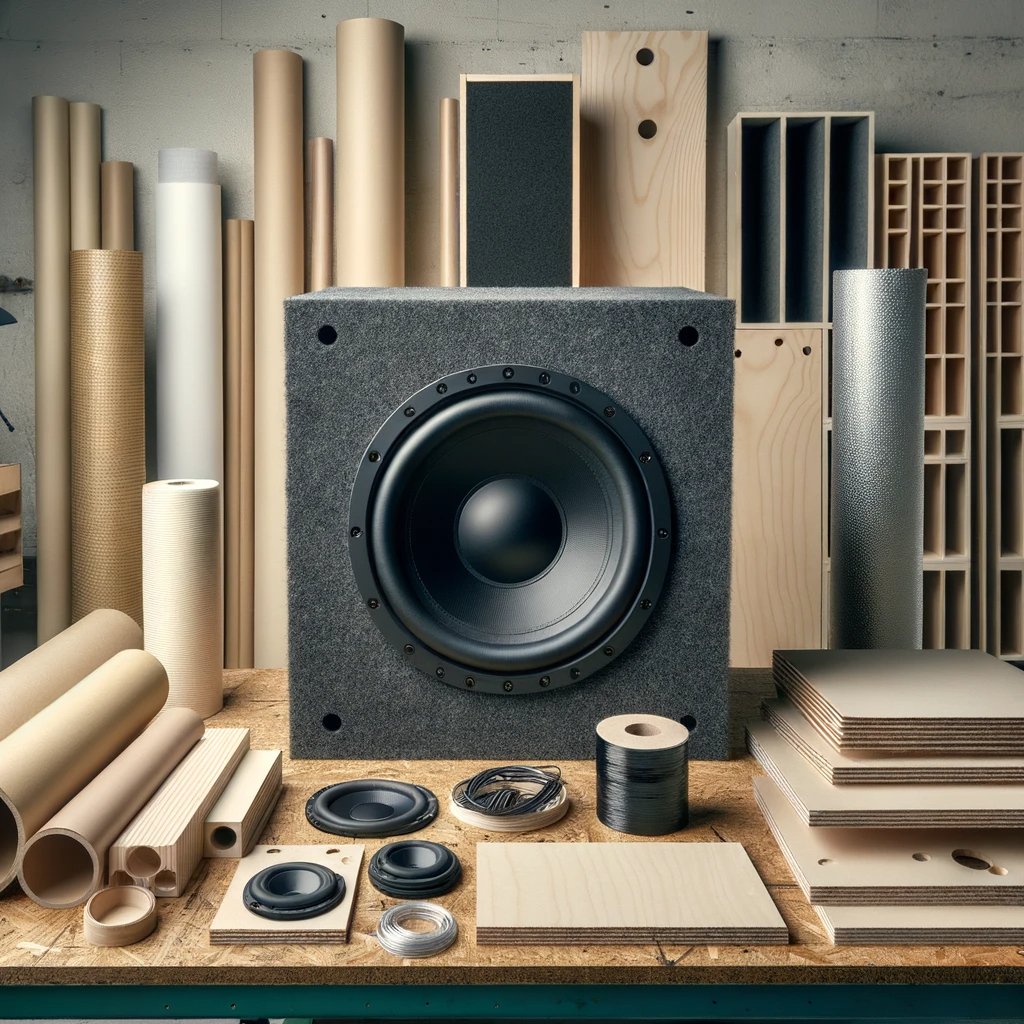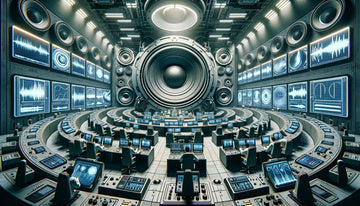
Top Material for Sub Box Building
Subwoofer boxes, or sub-boxes, play a crucial role in subwoofers' sound quality. These boxes provide the necessary enclosure and space for the subwoofer to perform optimally and improve bass response. When it comes to building sub-boxes, choosing materials is of utmost importance. Different materials offer varying levels of sound quality, durability, and versatility. This blog will explore the top materials used in sub-box building, their characteristics, and the factors to consider when choosing the best material for your sub-box to prevent woofer damage from over-excursion. The enclosure's walls should be as rigid as possible to minimize any flexing, which can drastically decrease your speakers' performance. Additionally, it is crucial to ensure that all of the joints and walls in a speaker enclosure, including the screw holes and wire holes, are airtight to prevent leaks and flexing that can cause cancellation and result in reduced output.
Exploring Different Sub-Box Building Materials
When constructing subwoofer enclosures, two materials consistently rise to the top as the most preferred options: Medium Density Fiberboard (MDF), high-density fiberboard, and plywood. Both of these materials have established a solid reputation for their reliability, durability, and their capability to facilitate the production of superb sound quality. Medium Density Fiberboard (MDF) is celebrated for its uniform and dense composition, significantly contributing to its sturdiness and the clarity of sound it helps produce. It's an engineered wood product made from wood fibers combined with wax and a resin binder under high temperatures and pressure. This meticulous process results in a robust material with a smooth surface, perfect for creating a sealed environment crucial for subwoofers to perform at their best.
Conversely, plywood is made by layering thin sheets of wood veneer, with each layer's grain oriented at right angles to adjacent layers, resulting in a resilient material against warping and cracking. This cross-grained structure enhances its strength and contributes to its ability to produce a clean and accurate bass response, making it another excellent choice for subwoofer enclosures. In summary, Medium Density Fiberboard (MDF), high-density fiberboard, and plywood stand out as the premier choices for building subwoofer boxes, owing to their proven track record of reliability, strength, and unparalleled ability to support the production of high-fidelity sound. Delving into the characteristics of each material, it becomes evident that their unique properties make them well-suited for this specific application, ensuring that audiophiles and enthusiasts alike are provided with the best possible auditory experience.
The Robustness of Medium Density Fiberboard (MDF)
MDF is the gold standard material for subwoofer boxes and speaker boxes, thanks to its density, stability, and high internal volume. The density of MDF ensures that the box remains sturdy, reducing resonance and minimizing distortion. Additionally, MDF is easy to work with, as it can be cut, shaped, and braced to precise dimensions, ensuring a tight enclosure for the subwoofer and speaker. The thickness of the wood used, internal bracing, and the quality of the subwoofer and speaker box construction also play significant roles in the sound quality produced by the subwoofer and speaker. MDF is usually available in a standard width but can also be found up to an inch thick. Overall, MDF subwoofer and speaker boxes provide better sound quality, minimizing resonance and reducing distortion.
The Versatility of Plywood in Sub Box Construction
Plywood is another popular material used in sub-box construction known for its strength, durability, and natural wood aesthetics. Birch plywood, in particular, is often used in high-end audio systems due to its superior sound quality. Plywood subwoofer boxes, including cylindrical ones and sonotubes, are sturdy, resistant to resonance, and provide better sound quality than particle board boxes. The type of wood, thickness, internal dimensions, and bracing of the plywood subwoofer box all affect the bass response and sound quality produced. Whether for car audio systems or home theater setups, plywood subwoofer boxes, including cylindrical subwoofer boxes, provide good sound quality and aesthetically pleasing natural wood finishes.
What is the best material for a sub-box?
Conclusion: The best material for a sub-box is typically a medium-density fiberboard (MDF). MDF is known for its durability, stability, and ability to minimize sound vibrations. It is also easier to work with than other materials like plywood or particle board.
Unconventional Materials in Sub-Box Building - Sonotube
While MDF and plywood are the go-to materials for building subwoofer boxes, unconventional materials are also worth considering. These materials offer unique advantages, such as flexibility, lightweight, and impact resistance, which can enhance the sound quality and durability of the subwoofer box.
Flexibility and Strength of Fiberglass
Fiberglass subwoofer boxes provide a good option for creating custom-shaped enclosures, making them ideal for car audio installations where space constraints require unconventional enclosure shapes. The high internal volume, strength, and rigidity of fiberglass contribute to better sound quality, minimizing resonance and distortion. Fiberglass subwoofer boxes offer better sound quality, durability, and the ability to create unique enclosure designs that fit seamlessly into the available space, improving proper performance. If you want subwoofer boxes that are strong yet light, fiberglass is a good option to choose. However, fiberglass is unsuitable for larger single panels, such as those used in high-end installations requiring large single panels. Fiberglass is easy to clean and will not react to temperature and weather. Cons include the limited power handling and output, as well as the exposed rear side of the driver and wiring, which may result in a less clean-looking installation.
The Use of Polycarbonate in Modern Sub Box Designs
Polycarbonate subwoofer boxes have gained popularity in modern audio setups thanks to their lightweight nature and high internal volume. Polycarbonate material is impact-resistant, making it suitable for car audio installations where the enclosure may be subject to vibrations or bumps. The increased internal volume of polycarbonate subwoofer boxes allows for better bass response, ensuring sound quality even in compact subwoofer boxes. Additionally, the material's versatility allows for the creation of sleek, modern designs, complementing the overall aesthetics of the audio system. Polycarbonate subwoofer boxes offer the benefits of lightweight construction, high internal volume, and impact resistance, ultimately improving sound quality and durability.
Factors to Consider When Choosing Sub Box Material
When selecting the material for your subwoofer box, there are a few key factors to consider. These factors will help you make an informed decision, ensuring the best sound quality and performance for your audio system.
Why is the Material Choice Critical for Sound Quality?
The material choice for subwoofer boxes is critical as it directly impacts the audio system's sound quality. Different materials have varying density, resonance, and distortion properties, affecting the subwoofer's bass response, resonance, distortion, and overall proper performance. High-quality materials like MDF and plywood, commonly used in subwoofer box construction, provide better sound quality, minimizing resonance and distortion. The thickness of the wood, internal bracing, and the quality of the subwoofer box construction also play significant roles in the sound quality produced. Therefore, selecting the suitable material and using appropriate fasteners for your subwoofer box ensures optimal sound reproduction, enhancing the audio listening experience. Learn more here.
What are the Cost Implications of Different Subwoofer Box Materials?
The cost of subwoofer box materials varies depending on the type of material, quality, and thickness of the wood. MDF subwoofer boxes are generally more cost-effective, providing good sound quality and high internal volume at a reasonable price. Plywood subwoofer boxes, especially those made of high-quality birch plywood, may be more expensive but offer superior sound quality. Unconventional materials like fiberglass and polycarbonate may cost more, but their unique advantages can justify the investment. Sonotube, a thick and sturdy cardboard tube, is also viable for cylindrical subwoofer boxes. It is commonly used when pouring concrete, and its cylindrical shape helps produce a good sound. It's essential to consider your budget, sound quality requirements, and the specific needs of your audio system when choosing the material for your subwoofer box.
Conclusion
In conclusion, choosing suitable materials for sub-box building is crucial for achieving the desired sound quality and durability. Medium Density Fiberboard (MDF) is popular due to its robustness and ability to minimize resonance. Plywood offers versatility and can be easily customized to meet specific design requirements. Fiberglass provides flexibility and strength for unconventional options, while polycarbonate offers modern aesthetics. Factors such as sound quality, cost implications, and design preferences should be considered when selecting materials. Remember, your chosen materials will significantly impact your sub-box's overall performance and longevity. So, take your time, research, and make an informed decision. Happy building! For an up-to-date guide on how to build a sub-enclosure. Check this out.

















